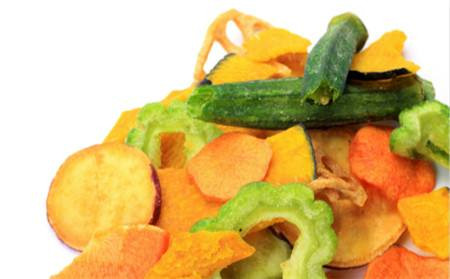Present situation of dehydration and drying technology for fruits and vegetables

The traditional drying methods of fruits, vegetables, Chinese medicinal materials and other agricultural products in our country usually adopt the method of direct exposure to sunlight and natural spreading. The drying cycle is longer, and it is vulnerable to clouds, rain, mosquitoes, microbial breeding and dust pollution. If ordinary drying room, hot air drying and other forms are used, it is easy to cause the loss of nutrients such as heat-sensitive vitamins, and serious power consumption, coal consumption, poor hygiene quality, unequal product quality shortcomings.
Microwave vacuum drying mechanical technology can effectively solve the above problems. The solar drying facility with drying chamber temperature of 45 ~60 ~C is used for dehydration, which has the advantages of low nutrient loss, high product quality, energy saving and environmental protection. About 2/3 of China's land area has sunshine time of more than 2,200 hours per year, radiation of more than 5,000 MJ/(m2.a), which is equivalent to the heat generated by standard coal combustion of more than 170 kg.
Especially in the areas with the most abundant solar energy resources, such as the Qinghai-Tibet Plateau, northern Gansu, northern Ningxia and southern Xinjiang, the annual sunshine time can reach up to 3,300 hours, and the radiation amount can reach 8,400 MJ/(m2.a), which is equivalent to the heat generated by standard coal combustion of about 285 kg.
Nowadays, climate change and energy conservation and emission reduction have become one of the topics of global concern. The concentration of carbon dioxide in the air has increased by 36% since the development of global industrialization, and more than 25 billion tons of carbon dioxide are emitted annually. With the aggravation of the global energy crisis, climate change and energy saving and emission reduction have attracted worldwide attention. The development and utilization of new energy sources, such as solar energy, wind energy and biomass energy, are gradually becoming the top priority in the development of low-carbon economy in various industries.
Today, with the rapid development of solar energy heat utilization technology, the use of microwave fruit and vegetable dryer for dehydration and drying of fruit and vegetable and other agricultural products has the advantages of clean and sanitary production environment, low loss of nutrients, energy saving and reducing drying costs, which has become an inevitable trend in the future development of fruit and vegetable industry.
Research and development trends of solar drying technology abroad
Overseas, the development and utilization of solar energy has become the focus of increasing attention, mainly in the fields of solar thermal utilization, solar power generation and crop drying. In the International Energy Agency (IEA) Solar Energy Heating and Refrigeration Program (SHC), a task force on "Solar Drying Crops" has also been set up. Its main members are Canada, the Netherlands and the United States. Solar energy projects developed include coffee, tobacco leaves, cereals, fruits, biomass and coconut peel fiber peat. .
In the United States, solar drying equipment has been commercialized in a certain amount, while in India, Thailand, Indonesia and other countries, there are also small batches of commercial applications. However, there are fewer commercial solar drying rooms in Europe. Overseas solar dryer mainly includes direct solar dryer, indirect solar dryer, composite solar dryer and hybrid solar dryer.